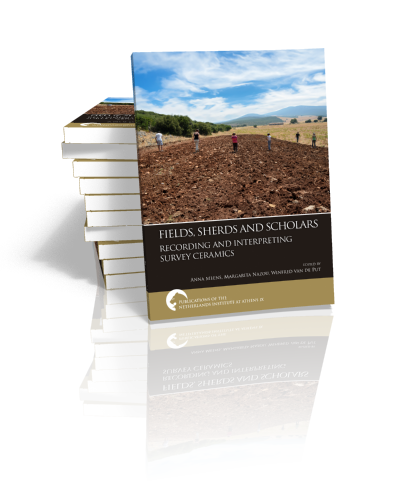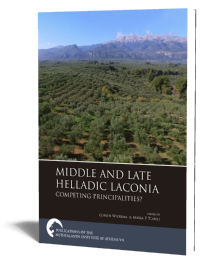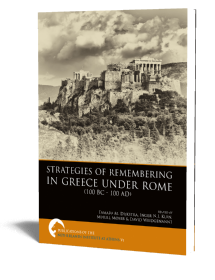Fields, Sherds and Scholars
Recording and Interpreting Survey Ceramics
Edited by Anna Meens, Margarita Nazou, Winfred van de Put | 2023

Fields, Sherds and Scholars
Recording and Interpreting Survey Ceramics
Edited by Anna Meens, Margarita Nazou, Winfred van de Put | 2023
Paperback ISBN: 9789464262094 | Hardback ISBN: 9789464262100 | Imprint: Sidestone Press | Format: 210x280mm | 170 pp. | Publications of the Netherlands Institute at Athens IX | Language: English | 12 illus. (bw) | 73 illus. (fc) | Keywords: archaeological survey; landscape; ceramics; statistics; pottery typology; function; chronology; Greek archaeology; Italian archaeology | download cover | DOI: 10.59641/m11443py
Read online 550 times
- Digital & Online access
-
Buy via Sidestone (EU & UK)
-
Buy via our Distributors (WORLD)
For non-EU or UK destinations you can buy our books via our international distributors. Although prices may vary this will ensure speedy delivery and reduction in shipping costs or import tax. But you can also order with us directly via the module above.
UK international distributor
USA international distributor
-
Bookinfo
Paperback ISBN: 9789464262094 | Hardback ISBN: 9789464262100 | Imprint: Sidestone Press | Format: 210x280mm | 170 pp. | Publications of the Netherlands Institute at Athens IX | Language: English | 12 illus. (bw) | 73 illus. (fc) | Keywords: archaeological survey; landscape; ceramics; statistics; pottery typology; function; chronology; Greek archaeology; Italian archaeology | download cover | DOI: 10.59641/m11443py
Read online 550 times

We will plant a tree for each order containing a paperback or hardback book via OneTreePlanted.org.
This book is a significant contribution to the field of survey pottery studies, which is not frequently theorised, and could also serve as a guide and provide inspiration to archaeologists designing their own survey projects and methodologies.
Landscape archaeology has heavily relied on pedestrian survey as a field method for more than half a century. In most field projects, archaeological ceramics constitute the lion’s share among the finds and the amount of collected sherds is overwhelming. Survey ceramics provide the basis for understanding human activity in a landscape, and sherds serve as convenient chronological markers for the archaeological sites discovered in field projects. However, how this pottery is collected and studied determines the possibilities for using the sherds as a source material. Not only the collection practices, but also the process and practicalities of ceramic analysis are rarely made explicit, even though the archaeological interpretations of human activity in the landscape strongly rely on it.
Most contributions in this volume provide an insight in collection, processing and interpretation practices in a specific survey project, and we hope this transparency is inspiring and contributes to a better understanding of surface ceramics as a basis for historical interpretations. Three themes run as a red thread through the contributions in this book: first of all transparency in ceramic collecting, processing and interpretation, secondly, improving diagnosticity, and thirdly, expanding the interpretive potential of survey ceramics.
The chapters are geographically oriented towards Greece, Italy and Spain, three countries in which archaeological surface survey is widely practised. Chronologically, the contributions range from the Final Neolithic to the Medieval period.
Survey ceramics in the spotlight
Anna Meens, Margarita Nazou & Winfred van de Put
Pottery studies in survey in the eastern Mediterranean over the last 20 years – a personal account
Kristina Winther-Jacobsen
Statistical distances on a map (STADION): a method for exploring intra-site variability of pottery assemblages
Jesús García Sánchez
Diagnostic visibility and problems of quantification in survey assemblages. Examples from the Mazi archaeological project (Northwest Attica)
Christian F. Cloke, Alex R. Knodell, Sylvian Fachard & Kalliopi Papangeli
Down to the details. The pottery recording methodology from the Kea Archaeological Research Survey
Margarita Nazou, Joanne Murphy, Natalie Abell, Shannon LaFayette Hogue & John Wallrodt
The potential of impasto pottery studies for understanding regional settlement dynamics, cultural transmission and connectivity in Bronze Age landscapes in Italy
Francesca Ippolito & Peter Attema
Survey, ceramics and statistics. The potential for technological traits as chronological markers
Ayla Krijnen, Jitte Waagen & Jill Hilditch
The analytical potential of intensive field survey data. Developments in the collection, analysis and interpretation of surface ceramics within the Pontine Region Project
Tymon de Haas & Gijs Tol
The Ayios Vasileios Survey Project. Diagnostic samples versus total samples and their biases
Corien W. Wiersma
Diagnosing the undiagnostic. Using sherd databases as a source of interpretation
Vladimir Stissi
Tales of two cities. Urban surveys of the Hellenistic and Roman cities of Sikyon and Knossos
Conor P. Trainor & Peter J. Stone
A case in point(s). The Late Hellenistic to Late Roman pottery from extra-mural Tanagra and the formation of the surface record: methodology, chronology and function
Dean Peeters, Philip Bes & Jeroen Poblome
Buried landscapes and landscapes of the buried. Considering rural burial in survey
Anna Meens
Dr. Margarita Nazou
Margarita Nazou is a post-doctoral researcher at the Institute of Historical Studies of the National Hellenic Research Foundation. She holds a PhD in Aegean Archaeology from the Institute of Archaeology, University College London and has worked as a post-doctoral researcher in Belgium (Ghent University and Université Catholique de Louvain) and Germany (Bochum University). She has worked as a ceramic specialist studying prehistoric pottery in several survey projects in Attica (Thorikos and Porto Rafti), the borders of Attica and Boeotia (Mazi) and the Greek islands (Kea and Knossos). She has published three peer-review articles in Shima: The International Journal of Research into Island Cultures and Pharos, the Journal of the Netherlands Institute at Athens and several collective book chapters on the pottery from Thorikos.
Anna Meens MA
Anna Meens is a PhD candidate at the University of Amsterdam. She has participated in multiple survey and excavation projects in Greece and Turkey as a pottery specialist (for example the Boeotia Survey, the excavations of the Halos Archaeological Project at Magoula Plataniotiki in Thessaly). Her main research interest is the ancient countryside (in the Classical and Hellenistic period), for which survey ceramics are a particularly useful source of information. In her research she attempts to characterize ancient Greek rural households through patterns of pottery consumption. Besides working on rural landscapes, she also studies pottery from city settlements: she contributed to the forthcoming volume about the Boeotian town of Hyettos (with Vladimir Stissi) and currently examines ceramics from the city of Koroneia. She has also written about the Classical and Hellenistic sites in the Valley of the Muses and on the Cycladic island of Keros, both awaiting publication.
Dr. Winfred van de Put
Winfred van de Put held the position of director of the Netherlands Institute at Athens from 2014 to 2022. He is a specialist in Attic and Apulian vase-painting, having studied at the University of Amsterdam in the eighties with Professors Hemelrijk and Brijder. He defended his PhD on the development of the iconography on lekythoi at Ghent University in 2012 and taught archaeology at the Universities of Amsterdam, Ghent and Nijmegen (Radboud) from 2005 to 2013. In 2013-2014 he briefly held a position of curator at the Allard Pierson Museum, for which he wrote two fascicles of the Corpus Vasorum Antiquorum (3 and 4, comprising all the lekythoi of the museum). He participated in field-work in Lakonia, Carthage, Sozopol (Apollonia Pontica), Boeotia, Thorikos and Halos, mostly involved in finds processing. He is member of the editorial board of Pharos.
Abstract:
This book is a significant contribution to the field of survey pottery studies, which is not frequently theorised, and could also serve as a guide and provide inspiration to archaeologists designing their own survey projects and methodologies.
Landscape archaeology has heavily relied on pedestrian survey as a field method for more than half a century. In most field projects, archaeological ceramics constitute the lion’s share among the finds and the amount of collected sherds is overwhelming. Survey ceramics provide the basis for understanding human activity in a landscape, and sherds serve as convenient chronological markers for the archaeological sites discovered in field projects. However, how this pottery is collected and studied determines the possibilities for using the sherds as a source material. Not only the collection practices, but also the process and practicalities of ceramic analysis are rarely made explicit, even though the archaeological interpretations of human activity in the landscape strongly rely on it.
Most contributions in this volume provide an insight in collection, processing and interpretation practices in a specific survey project, and we hope this transparency is inspiring and contributes to a better understanding of surface ceramics as a basis for historical interpretations. Three themes run as a red thread through the contributions in this book: first of all transparency in ceramic collecting, processing and interpretation, secondly, improving diagnosticity, and thirdly, expanding the interpretive potential of survey ceramics.
The chapters are geographically oriented towards Greece, Italy and Spain, three countries in which archaeological surface survey is widely practised. Chronologically, the contributions range from the Final Neolithic to the Medieval period.
Contents
Survey ceramics in the spotlight
Anna Meens, Margarita Nazou & Winfred van de Put
Pottery studies in survey in the eastern Mediterranean over the last 20 years – a personal account
Kristina Winther-Jacobsen
Statistical distances on a map (STADION): a method for exploring intra-site variability of pottery assemblages
Jesús García Sánchez
Diagnostic visibility and problems of quantification in survey assemblages. Examples from the Mazi archaeological project (Northwest Attica)
Christian F. Cloke, Alex R. Knodell, Sylvian Fachard & Kalliopi Papangeli
Down to the details. The pottery recording methodology from the Kea Archaeological Research Survey
Margarita Nazou, Joanne Murphy, Natalie Abell, Shannon LaFayette Hogue & John Wallrodt
The potential of impasto pottery studies for understanding regional settlement dynamics, cultural transmission and connectivity in Bronze Age landscapes in Italy
Francesca Ippolito & Peter Attema
Survey, ceramics and statistics. The potential for technological traits as chronological markers
Ayla Krijnen, Jitte Waagen & Jill Hilditch
The analytical potential of intensive field survey data. Developments in the collection, analysis and interpretation of surface ceramics within the Pontine Region Project
Tymon de Haas & Gijs Tol
The Ayios Vasileios Survey Project. Diagnostic samples versus total samples and their biases
Corien W. Wiersma
Diagnosing the undiagnostic. Using sherd databases as a source of interpretation
Vladimir Stissi
Tales of two cities. Urban surveys of the Hellenistic and Roman cities of Sikyon and Knossos
Conor P. Trainor & Peter J. Stone
A case in point(s). The Late Hellenistic to Late Roman pottery from extra-mural Tanagra and the formation of the surface record: methodology, chronology and function
Dean Peeters, Philip Bes & Jeroen Poblome
Buried landscapes and landscapes of the buried. Considering rural burial in survey
Anna Meens
Dr. Margarita Nazou
Margarita Nazou is a post-doctoral researcher at the Institute of Historical Studies of the National Hellenic Research Foundation. She holds a PhD in Aegean Archaeology from the Institute of Archaeology, University College London and has worked as a post-doctoral researcher in Belgium (Ghent University and Université Catholique de Louvain) and Germany (Bochum University). She has worked as a ceramic specialist studying prehistoric pottery in several survey projects in Attica (Thorikos and Porto Rafti), the borders of Attica and Boeotia (Mazi) and the Greek islands (Kea and Knossos). She has published three peer-review articles in Shima: The International Journal of Research into Island Cultures and Pharos, the Journal of the Netherlands Institute at Athens and several collective book chapters on the pottery from Thorikos.
Anna Meens MA
Anna Meens is a PhD candidate at the University of Amsterdam. She has participated in multiple survey and excavation projects in Greece and Turkey as a pottery specialist (for example the Boeotia Survey, the excavations of the Halos Archaeological Project at Magoula Plataniotiki in Thessaly). Her main research interest is the ancient countryside (in the Classical and Hellenistic period), for which survey ceramics are a particularly useful source of information. In her research she attempts to characterize ancient Greek rural households through patterns of pottery consumption. Besides working on rural landscapes, she also studies pottery from city settlements: she contributed to the forthcoming volume about the Boeotian town of Hyettos (with Vladimir Stissi) and currently examines ceramics from the city of Koroneia. She has also written about the Classical and Hellenistic sites in the Valley of the Muses and on the Cycladic island of Keros, both awaiting publication.
Dr. Winfred van de Put
Winfred van de Put held the position of director of the Netherlands Institute at Athens from 2014 to 2022. He is a specialist in Attic and Apulian vase-painting, having studied at the University of Amsterdam in the eighties with Professors Hemelrijk and Brijder. He defended his PhD on the development of the iconography on lekythoi at Ghent University in 2012 and taught archaeology at the Universities of Amsterdam, Ghent and Nijmegen (Radboud) from 2005 to 2013. In 2013-2014 he briefly held a position of curator at the Allard Pierson Museum, for which he wrote two fascicles of the Corpus Vasorum Antiquorum (3 and 4, comprising all the lekythoi of the museum). He participated in field-work in Lakonia, Carthage, Sozopol (Apollonia Pontica), Boeotia, Thorikos and Halos, mostly involved in finds processing. He is member of the editorial board of Pharos.
- Digital & Online access
-
Buy via Sidestone (EU & UK)
-
Buy via our Distributors (WORLD)
For non-EU or UK destinations you can buy our books via our international distributors. Although prices may vary this will ensure speedy delivery and reduction in shipping costs or import tax. But you can also order with us directly via the module above.
UK international distributor
USA international distributor
- Browse all books by subject
-
Search all books

We will plant a tree for each order containing a paperback or hardback book via OneTreePlanted.org.
You might also like:
© 2025 Sidestone Press KvK nr. 28114891 Privacy policy Sidestone Newsletter Terms and Conditions (Dutch)







